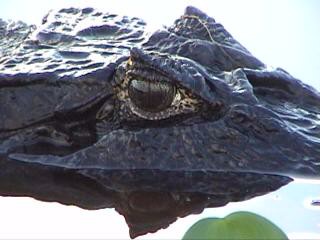
Cross-Posted from Biodiversivist
To get to this wildlife preserve from Seattle, fly for about 15 hours to Buenos Aires. Rent a car, load it with your family and drive North toward Brazil for a day or so to a small town called Collinia Carlos Pellegrini where you will find a dirt road. Drive down that dirt road for three hours. Cross a rickety one-lane wooden bridge.
Go here for some very amateur video footage of some of the wildlife found there, which represents just the tip of the very large iceberg that we saw and did not see. Go here for footage of a rhinoceros beetle named Rotifer and a three-inch long inchworm, who’s name I never caught.
The highlight for me was seeing one of these monsters. I didn’t get a picture of him but I did get some footage of a freshly hatched version.
Next in line were the wild rheas. Birds are the only remaining species of dinosaur. It’s easy to imagine rheas with scales and teeth instead of feathers and beaks.
Finally, there were the Geoffroy’s Cats. The first time I saw one I blew it off as just a feral house cat. Came to find out at the visitor’s center that it was a native cat about the same size as a domesticated cat. We spotted a total of four (three at night) and they were all jet black (melanistic). Apparently they are still hunted for fur coats. How’s that for stupid?
The landscape outside of Buenos Aires is similar to our own great plains except there are large areas of marsh and river flood plains as well. There are very few trees and what trees you do find are in tree farms–eucalyptus and pine. Anyplace there is enough water you find vast fields of soy or corn or whatever. Everything in-between is used for cattle pasture. It is vast, flat, and thinly populated but not wild. Other than birds, you will see no wildlife for 500 miles–not too different from our own farm belt.
Things change a few minutes after turning onto the dirt road leading to the preserve. The first animal spotted was a wild guinea pig. The road was lined with hundreds of species of birds, which flew or ran out of our way for three straight hours. I’ve never seen so many kinds of hawks, owls, and every other raptor species you can think of.
The preserve contained a village with a few small hotels, dirt streets, and small houses. The residents eek out a living giving horseback, boat, and nighttime wildlife spotting tours. They also keep some sheep, chickens, and cattle. I saw no subsistence farming. We were told that the average family size was about 6 kids. There were about as many dogs as there were people but interestingly enough, I did not see a single pet cat. My guess is that they are too vulnerable to the local wildlife.
Even with the people and dogs, this place was a riot of wildlife, with birds, bugs, and frogs everywhere you looked. It’s an example of what happens if you can stop hunting, fishing, and large scale agriculture. Imagine what it would be like without the dogs! Unlike most American dogs, these actually have a utilitarian purpose, serving as biological burglar alarms. Man’s only real predator is man.
We drove out at dusk and spent the next three hours viewing in our headlights foxes, owls, skunks, jack rabbits, tarantulas, armadillos, Geoffroy’s cats, and capybaras. The car bottomed out a few times in deep ruts, but we sure got our money’s worth out of it.
Agriculture is consuming the planet. Every few miles along this dirt road, in fact along every road, day and night, lumbered a tractor trailer rig hauling agricultural products and supplies to or from some distant field.
You think meat is big in America? It’s practically all they eat in Argentina. The last thing this planet needs is unnecessary expansion of agriculture. How can growing palm or soy or corn for car fuel not pour gas on that fire? A recent study has been published that shows most ecosystem destruction is being driven by commodity crops for international trade, not local subsistence farmers.
From a very interesting article found on Mongabay:
…a community today may see an ecosystem as ‘pristine’ or ‘complete’, which their grandparents would view as hopelessly degraded. In turn what the current generation sees as a degraded environment, the next generation will see as ‘natural’.


